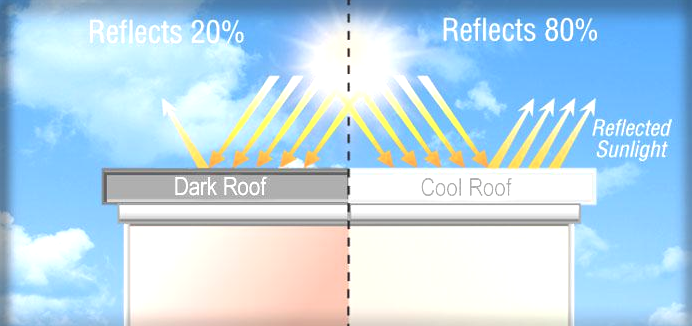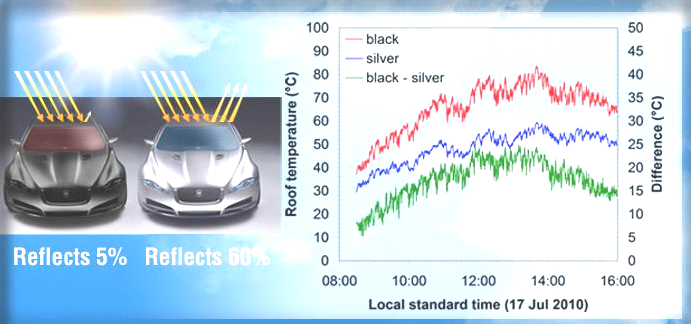 I COME FROM AN ERA WHEN “COOL” had other connotations than the temperature. It could be a pronouncement of an exciting or inspiring idea or thing. In the case of cool roofs, in my mind, the word speaks to both the temperature AND an exciting concept.
I COME FROM AN ERA WHEN “COOL” had other connotations than the temperature. It could be a pronouncement of an exciting or inspiring idea or thing. In the case of cool roofs, in my mind, the word speaks to both the temperature AND an exciting concept.
In fact, there is a Heat Island Group at Lawrence Berkeley National Laboratory that “works to cool buildings, cities and the planet by making roofs, pavements and cars cooler in the sun.” At their website they have a series of graphs that show just how much sunlight is reflected by a light-colored car versus a dark-colored car — 60 percent! The reflection of sunlight is even higher — 80 percent — for a building roof that is white versus a roof that is dark. The same holds true for pavement. A cool pavement that is light gray versus black reflects 40 percent of sunlight. The black pavement reflects 10 percent, thereby retaining 90 percent that is radiated into the atmosphere as heat.
Less retention of sunlight as heat is good because we don’t have to run air conditioners as much (saving money by saving energy and decreasing greenhouse gases as well). The formation of smog is slowed, thereby improving air quality.
Now, a cool roof is not a solution for every state in the Union. If you live in Bemidji, Minn., for example, a “hot” or dark roof helps out in the winter in cutting down on heating costs. In California, it does make sense. I have a standard asphalt shingle roof and I was lucky in my color choice because it is a light-colored roof. But when I need to replace my shingles, I will definitely select a cool roofing solution. I found there is a Cool Roof Rating Council located in Oakland that has a “Rated Products Directory.” You can filter the directory by asphalt shingles, concrete/clay tile and slates, metal products, polymer and composites, etc. To see what was available in asphalt shingles, I filtered the results by asphalt, color and initial solar reflectance. I was amazed to see the quantity and variety of products and manufacturers: CertainTeed Corporation, PABCO, Owens Corning and more. If you click the “more info” link, a pop-up even provides a contact name, phone number and website.
 The other thing I did several years ago with my home energy upgrade was install a radiant barrier under my roof. This barrier looks like a heavy-duty aluminum foil that is put up in between the roof joists. The radiant barrier helps me in my home, along with a LOT of good insulation (I have a R39 insulation rating in my attic). But I know from the research that if I had a cool roof as well, not only would my home stay cooler but I wouldn’t be putting as much reflective heat into the atmosphere.
The other thing I did several years ago with my home energy upgrade was install a radiant barrier under my roof. This barrier looks like a heavy-duty aluminum foil that is put up in between the roof joists. The radiant barrier helps me in my home, along with a LOT of good insulation (I have a R39 insulation rating in my attic). But I know from the research that if I had a cool roof as well, not only would my home stay cooler but I wouldn’t be putting as much reflective heat into the atmosphere.
I can tell you that I haven’t had to use my air conditioner in over two years. With the past week being so warm, there is more than a twenty degree temperature difference between outside and inside because of my good insulation and the radiant barrier.
The good news for everyone is that the HERO program that I’ve mentioned in previous articles will help in the financing of energy upgrades such as cool roofs, energy upgrades and radiant barriers. See the link below.
We’ve come a long way!
One of our truly inspiring and leading Benicia proponents of living intelligently and sustainably, Mary Frances Kelly Poh, now has two electric cars! She and her husband have a Nissan Leaf and a new Chevy Volt. They also have a home solar system! Mary Frances said in the month of owning and driving the Volt, which also can operate on gas, she has used about 2 1/2 gallons of gas. Meanwhile, the house solar system is still pumping out enough electricity for all their needs.
Since I’ve been writing about electric cars, a lot more models have become available for our consideration. Here’s the list of both battery electric vehicles and plug-in hybrids:
• BMW i3 — 81 miles (pure electric), $42,300 *
• BMW i8 — 25 miles (electric and gasoline) $137,000
• Cadillac ELR — 35 miles (electric and gasoline) $76,000 **
• Chevy Spark EV — 82 miles (pure electric) $27,5000 *
• Chevy Volt — 38 miles (electric and gasoline) $35,000 **
• Fiat 500e — 87 mils (pure electric) $32,600 *
• Ford C-Max Energi — 21 miles (electric and gasoline) $33,700 **
• Ford Focus Electric — 76 miles (pure electric) $36,000 *
• Ford Fusion Energi — 21 miles (electric and gasoline) $35,500 **
• Honda Accord Plug-in Hybrid — 13 miles (electric and gasoline) $40,700 **
• Kia Soul EV — 93 miles (pure electric) $34,500 *
• Mercedes B-Class Electric Drive — 85 miles (pure electric) $42,400 *
• Mitsubishi iMiEV — 62 miles (pure electric) $23,800 *
• Nissan LEAF — 84 miles (pure electric) $29,800 *
• Porsche Panamera S E-Hybrid — 22 miles (electric and gasoline) $100,000
• Smart Electric Drive — 68 miles (pure electric) $25,700
• Tesla Model S — 265 miles (pure electric) $81,000
• Tesla Model X — 230 miles (pure electric) $80,000
• Toyota Prius Plug-in Hybrid — 11 miles (electric and gasoline) $30,800 **
• Toyota RAV4 EV — 100 miles (pure electric) $50,000 *
• Volkswagen E-Gold — 85 miles (pure electric) $36,300
* A California Tax credit incentive of $2,500 is available for the cars listed above
** $1,500 California tax credit for those listed above
Tax incentives
Depending on the size of the battery in the car, there is a federal tax credit of $2,500 to $7,500. For example, the Chevy Volt, with a 16kW battery pack, is eligible for a $7,500 federal rebate along with the BMW 2014 i3 Sedan. I have a link to the Federal Tax Credit site below.
When factoring in the cost of a new car, state and federal tax incentives and the cost of electricity compared to the cost of gasoline over the life of the car, it becomes very clear that electric — or at least electric hybrids — make sense.
Learn more
• California Clean Vehicle Rebates: energycenter.org/clean-vehicle-rebate-project
• Federal Tax Credit: fueleconomy.gov/feg/taxevb.shtml
• Heat Island Lab, Berkeley: Hot Roofs map: albedomap.lbl.gov
• Heat Island Group: heatisland.lbl.gov
• HERO Program: heroprogram.com
Constance Beutel is the chair of Benicia’s Community Sustainability Commission. She is a university professor and videographer and holds a doctorate from the University of San Francisco.







Above the fold and right next to Bob Livesays LTTE. How better can it get for you Constance. Above the fold and next to the informative one. I see you do write about electric/hybrid cars and are Chair of the CSC as your ID says. Now that is very interesting. You have also written about the 28 foot windmills with pictures and all. So as a Chair of the CSC you do make recommendations on sustainible issues. In this case electric/hybrid cars. Now if that is not the chair of the CSC telling the residents what to drive. Just what is it. Remeber the only purpose of the CSC is a Climate Action Plan and how to reach the mandates. So recomemndations become nore than suggestions they become the only alternative to reach the CAP goal. I loved the one about the 28 foot windmills also. Taking us back to the 40/50s with roof top antenns. Oh those were the days. News Flash: Attention former chair and now member of the CSC= I am correct again.
And, just so we don’t forget the motorcycle aficionados amongst us (mandate free, of course); Zero is making waves.
http://www.zeromotorcycles.com/zero-s/
https://www.youtube.com/watch?feature=player_embedded&v=MNktkD_8wbY